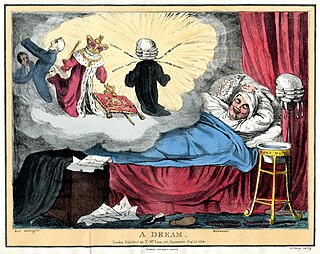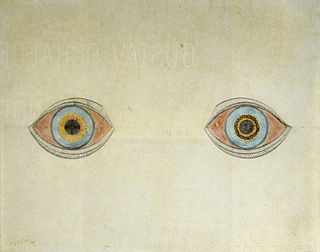Related Research Articles
In the field of oneirology, a lucid dream is a type of dream in which the dreamer becomes aware that they are dreaming while they are dreaming. It is a trainable skill. During a lucid dream, the dreamer may gain some amount of control over the dream characters, narrative, or environment, although this control of dream content is not the salient feature lucid dreaming. Lucid dreaming has been studied and reported for many years. Prominent figures from ancient to modern times have been fascinated by lucid dreams and have sought ways to better understand their causes and purpose.
Psychosis is a condition of the mind that results in difficulties determining what is real and what is not real. Symptoms may include delusions and hallucinations, among other features. Additional symptoms are incoherent speech and behavior that is inappropriate for a given situation. There may also be sleep problems, social withdrawal, lack of motivation, and difficulties carrying out daily activities. Psychosis can have serious adverse outcomes.

A dream is a succession of images, ideas, emotions, and sensations that usually occur involuntarily in the mind during certain stages of sleep. Humans spend about two hours dreaming per night, and each dream lasts around 5 to 20 minutes, although the dreamer may perceive the dream as being much longer than this.

A hallucination is a perception in the absence of an external stimulus that has the qualities of a real perception. Hallucinations are vivid, substantial, and are perceived to be located in external objective space. Hallucination is a combination of two conscious states of brain wakefulness and REM sleep. They are distinguishable from several related phenomena, such as dreaming, which does not involve wakefulness; pseudohallucination, which does not mimic real perception, and is accurately perceived as unreal; illusion, which involves distorted or misinterpreted real perception; and mental imagery, which does not mimic real perception, and is under voluntary control. Hallucinations also differ from "delusional perceptions", in which a correctly sensed and interpreted stimulus is given some additional significance. Many hallucinations happen also during sleep paralysis.

An out-of-body experience is a phenomenon in which a person perceives the world from a location outside their physical body. An OBE is a form of autoscopy, although this term is more commonly used to refer to the pathological condition of seeing a second self, or doppelgänger.

Sleep paralysis is a state, during waking up or falling asleep, in which one is conscious but in a complete state of full-body paralysis. During an episode, one may hallucinate, which often results in fear. Episodes generally last no more than a few minutes. It can recur multiple times or occur as a single episode.
In psychology, schizotypy is a theoretical concept that posits a continuum of personality characteristics and experiences, ranging from normal dissociative, imaginative states to extreme states of mind related to psychosis, especially schizophrenia. The continuum of personality proposed in schizotypy is in contrast to a categorical view of psychosis, wherein psychosis is considered a particular state of mind, which the person either has or does not have.
A false awakening is a vivid and convincing dream about awakening from sleep, while the dreamer in reality continues to sleep. After a false awakening, subjects often dream they are performing daily morning routine such as showering, cooking, cleaning, eating, and using the bathroom. False awakenings, mainly those in which one dreams that they have awoken from a sleep that featured dreams, take on aspects of a double dream or a dream within a dream. A classic example is the double false awakening of the protagonist in Gogol's Portrait (1835).
Celia Elizabeth Green is a British parapsychologist and writer on parapsychology.
Closed-eye hallucinations and closed-eye visualizations (CEV) are hallucinations that occur when one's eyes are closed or when one is in a darkened room. They can be a form of phosphene. Some people report CEV under the influence of psychedelics; these are reportedly of a different nature than the "open-eye" hallucinations of the same compounds. Similar hallucinations that occur due to loss of vision are called visual release hallucinations.

Sylvan Muldoon was an American esotericist who promoted the concept of astral projection. According to Muldoon, astral projection is an out-of-body experience (OBE) that assumes the existence of an astral body separate from the physical body and is capable of travelling outside it. A 2012 Princeton University Press publication by Hugh Urban asserted that one of Muldoon's most popular books formed the basis for theories of the Church of Scientology founder L. Ron Hubbard which he claimed were his own.

A form constant is one of several geometric patterns which are recurringly observed during hypnagogia, hallucinations and altered states of consciousness.
Gordon Sidney Claridge was a British psychologist and author, best known for his theoretical and empirical work on the concept of schizotypy or psychosis-proneness.
In parapsychology, an apparitional experience is an anomalous experience characterized by the apparent perception of either a living being or an inanimate object without there being any material stimulus for such a perception.
Anomalous experiences, such as so-called benign hallucinations, may occur in a person in a state of good mental and physical health, even in the apparent absence of a transient trigger factor such as fatigue, intoxication or sensory deprivation.
An auditory hallucination, or paracusia, is a form of hallucination that involves perceiving sounds without auditory stimulus. While experiencing an auditory hallucination, the affected person would hear a sound or sounds which did not come from the natural environment.
Hypnopompia is the state of consciousness leading out of sleep, a term coined by the psychical researcher Frederic Myers. Its mirror is the hypnagogic state at sleep onset; though often conflated, the two states are not identical and have a different phenomenological character. Hypnopompic and hypnagogic hallucinations are frequently accompanied by sleep paralysis, which is a state wherein one is consciously aware of one's surroundings but unable to move or speak.
K-hole is the feeling of getting a high enough dose of ketamine to experience a state of dissociation. This intense detachment from reality is often a consequence of accidental overconsumption of ketamine; however, some users consciously seek out the k-hole as they find the powerful dissociative effects to be quite pleasurable and enlightening. Regardless of the subjective experiences of k-holing, there are many psychological and physical risks associated with such high levels of ketamine consumption.
In psychology, anomalistic psychology is the study of human behaviour and experience connected with what is often called the paranormal, with few assumptions made about the validity of the reported phenomena.

Lucid Dreams 0096 is a 1996 ambient album, on the em:t label. It is credited to "0096", but this is merely the sequential catalogue number of the disc, labelled in em:t’s house style – the actual instrumentation on the album was provided by Miasma and Bad Data, two em:t artists.
References
- ↑ Charles McCreery, Schizotypy and Out-of-the-Body Experiences, DPhil thesis, University of Oxford, 1993.
- ↑ Green, C., and McCreery, C., Apparitions. London: Hamish Hamilton, 1975
- ↑ "Dream dreams". The Guardian . 19 October 1994.
These case histories have been edited from Lucid Dreaming: the paradox of consciousness during sleep, by Celia Green and Charles McCreery. Published by Routledge
ProQuest 293528536 - ↑ Ilman, John (19 October 1994). "Self-awareness in dreams is more common than we think. So why do those who inhabit a shimmering nocturnal world keep quiet about it?". The Guardian . ProQuest 293508330
- ↑ Simons, Paul (26 December 1994). "Balls of fire, rain of fish, and other very weird phenomena". Pittsburgh Post - Gazette .
Psychologists Celia Green and Charles McCreery put a lot of these sightings down to an unusual state of sleep. In their recent book "Lucid Dreaming" (published in Britain by Rotledge) they explain that the dreamers think they are wide awake but all their electrical brain waves show they're in a deep sleep and their visions are, in fact, dreams.
ProQuest 391872813 - ↑ Green, C., and McCreery, C., Lucid Dreaming: the Paradox of Consciousness During Sleep (1994). London: Routledge.
- ↑ McCreery, C., ‘Hallucinations and arousability: pointers to a theory of psychosis’, in Schizotypy, Implications for Illness and Health, ed. Gordon Claridge. Oxford: Oxford University Press, 1997, pp.251–273.
- ↑ http://www.celiagreen.com/charlesmccreery/dreams-and-psychosis-online.pdf [ bare URL PDF ]
- ↑ http://www.celiagreen.com/charlesmccreery/perception-and-hallucination-online.pdf [ bare URL PDF ]
- ↑ "Charles McCreery".
- ↑ The Abolition of Genius. Foreword by Professor Hans Eysenck. Oxford: Oxford Forum, 2012.
- ↑ "Apparitions". Kirkus Reviews . 1 February 1976. Retrieved 1 June 2023.
- ↑ Reviews of Lucid Dreaming
- Blake, Robin (30 October 1994). "BOOK REVIEW: Lucid Dreaming: The Paradox of Consciousness During Sleep - Celia Green and Charles McCreery: Routledge". The Independent . ProQuest 313259788
- Lezard, Nicholas (1 September 1995). "Books: Paperbacks". The Guardian . ProQuest 294986006